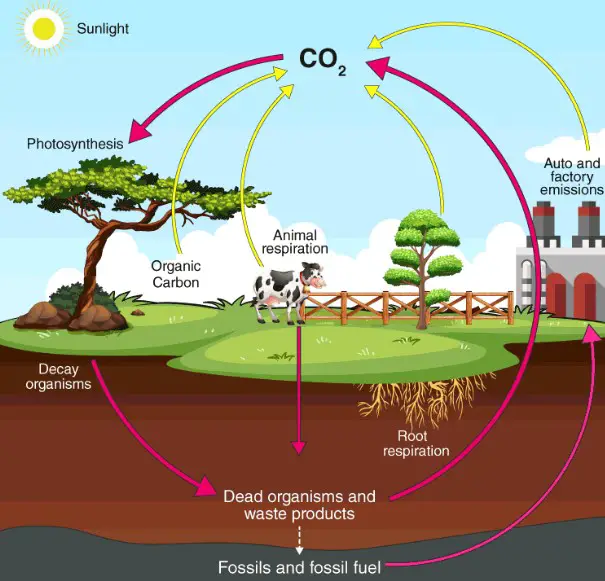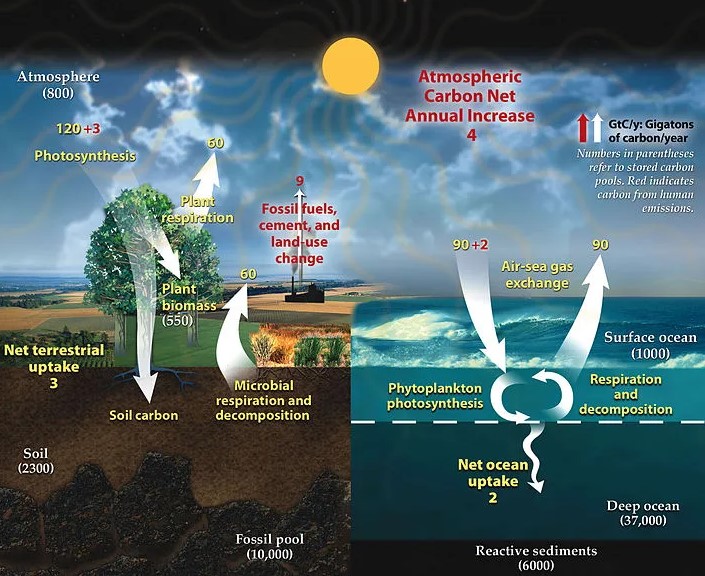Biogeochemical cycles are fundamental processes that recycle essential elements through the Earth’s ecosystems, supporting life and maintaining the balance of our planet’s environment. Among these, the carbon and phosphorus cycles stand out for their crucial roles in regulating climate, soil fertility, and the overall health of terrestrial and aquatic ecosystems. These cycles, though interconnected, operate through distinct mechanisms and have unique impacts on the Earth’s biosphere.
The carbon cycle and phosphorus cycle differ primarily in their processes, locations, and effects on the Earth’s systems. The carbon cycle is pivotal in controlling Earth’s temperature and climate by cycling carbon dioxide between the atmosphere, oceans, and living organisms. In contrast, the phosphorus cycle is essential for DNA, RNA, and ATP synthesis in living organisms, cycling phosphorus through rocks, water, soil, and biota, without an atmospheric component.
The carbon cycle’s influence extends from the ocean depths to the atmosphere, driving climate change through greenhouse gas concentrations. Meanwhile, the phosphorus cycle is vital for life but operates more slowly, primarily affecting aquatic and soil ecosystems without directly impacting the atmosphere. These differences highlight the unique contributions and challenges each cycle presents to environmental sustainability and climate regulation.

Carbon Cycle Basics
Definition and Importance
The carbon cycle is a natural process that cycles carbon among the atmosphere, oceans, soil, and living organisms. It is crucial for regulating Earth’s temperature, climate, and supporting life by ensuring a constant supply of carbon, a building block of life.
Major Processes Involved
Photosynthesis
- Plants absorb carbon dioxide (CO2) from the atmosphere and water from the soil, using sunlight as energy to produce oxygen and glucose, a form of sugar.
Respiration
- Living organisms, including plants, animals, and microbes, consume oxygen and glucose to produce energy, releasing carbon dioxide and water as byproducts.
Decomposition
- After organisms die, decomposers like bacteria and fungi break down their bodies, returning carbon to the soil and, eventually, the atmosphere as CO2.
Combustion
- The burning of fossil fuels and biomass releases stored carbon back into the atmosphere as CO2, contributing to the greenhouse effect.
Carbon Sinks and Sources
- Sinks are reservoirs that absorb more carbon than they release, like forests and oceans.
- Sources release more carbon than they absorb, including fossil fuel combustion and deforestation.
Phosphorus Cycle Basics
Definition and Significance
The phosphorus cycle involves the movement of phosphorus through the lithosphere, hydrosphere, and biosphere. Unlike carbon, phosphorus is not found in the gas phase in the atmosphere. It is essential for DNA, RNA, and ATP synthesis, playing a vital role in energy transfer within organisms.
Key Processes
Weathering of Rocks
- Phosphorus is released into the soil and water through the weathering of rocks over millions of years.
Absorption by Plants
- Plants absorb phosphorus from the soil, incorporating it into their biological processes.
Incorporation into Animal Diets
- Animals obtain phosphorus by eating plants or other animals, incorporating it into their bodies.
Return to Soil through Waste and Decomposition
- When plants and animals die or excrete waste, phosphorus returns to the soil or water, completing the cycle.
Phosphorus Sinks and Reserves
- The main sinks for phosphorus are soil and sedimentary rock formations. Unlike carbon, there are no significant atmospheric phosphorus sinks.
Comparative Overview
Carbon vs. Phosphorus: Elemental Properties
Carbon and phosphorus are both essential elements in biological molecules but differ in their environmental pathways and impacts. Carbon is a key component of CO2, a greenhouse gas, whereas phosphorus does not have a gaseous form under Earth’s conditions and is primarily found in phosphate (PO4^3-) ions in soil and water.
Role in Ecosystems
The carbon cycle plays a pivotal role in regulating global climate and temperature through the greenhouse effect. On the other hand, the phosphorus cycle is critical for nutrient cycling, directly impacting plant growth and productivity, especially in aquatic systems where it is often a limiting nutrient.
Impact on Living Organisms
Both cycles are vital for life. Carbon is the backbone of organic molecules such as carbohydrates, proteins, and fats. Phosphorus is key for energy transfer (ATP), genetic material (DNA and RNA), and cell membranes. However, their imbalance can lead to environmental issues like global warming (excess carbon) and eutrophication (excess phosphorus) in water bodies.

Key Differences Between the Carbon and Phosphorus Cycles
The carbon and phosphorus cycles are pivotal for life on Earth, yet they exhibit distinct characteristics that affect ecosystems in varied ways. Let’s explore these differences in detail.
Cycle Locations
Carbon: Atmospheric vs. Terrestrial
The carbon cycle spans across the atmosphere, terrestrial biosphere, oceans, and the earth’s crust, making it a truly global cycle. Carbon’s ability to form both organic and inorganic compounds allows it to move through the atmosphere as carbon dioxide, support life as part of biological molecules, dissolve in oceans, and be sequestered in rocks and fossil fuels.
Phosphorus: Terrestrial and Aquatic, No Atmospheric Phase
In contrast, the phosphorus cycle primarily operates in terrestrial and aquatic ecosystems with no significant atmospheric phase. Phosphorus moves through the soil, water bodies, and living organisms but does not become a gas under Earth’s conditions, limiting its mobility and cycle speed.
Impact on Climate
Carbon Cycle’s Role in Greenhouse Effect
The carbon cycle is intimately linked with the greenhouse effect. Carbon dioxide, a crucial component of the cycle, is a greenhouse gas that traps heat in the atmosphere, regulating Earth’s temperature. However, human activities have significantly increased CO2 levels, enhancing the greenhouse effect and contributing to global warming.
Phosphorus Cycle’s Lack of Direct Impact on Climate
The phosphorus cycle does not directly influence the climate since phosphorus does not have a gaseous form that could contribute to the greenhouse effect. However, it plays a critical role in biological processes that can indirectly affect climate, such as plant growth, which influences carbon sequestration.
Human Influence
Carbon: Fossil Fuel Combustion and Deforestation
Human activities, notably fossil fuel combustion and deforestation, have dramatically altered the carbon cycle. Burning fossil fuels releases immense amounts of CO2, while deforestation decreases the number of trees available to absorb CO2, exacerbating climate change.
Phosphorus: Agriculture and Wastewater Treatment
Human impact on the phosphorus cycle is primarily through agriculture and wastewater treatment. The use of phosphorus-rich fertilizers leads to runoff that can pollute water bodies, causing eutrophication. Meanwhile, inefficiencies in wastewater treatment can lead to the loss of valuable phosphorus resources.
Renewal and Recycling Rates
Carbon: Rapid Recycling
The carbon cycle features relatively rapid recycling processes, with carbon dioxide being quickly absorbed and released by plants and the ocean. This dynamic nature allows for quick adjustments but also means that human-induced changes can swiftly impact the cycle.
Phosphorus: Slow and Geologically Paced
The phosphorus cycle is much slower, primarily because phosphorus availability is limited to the weathering of rocks, a geologically paced process. This slow pace means that once phosphorus enters aquatic ecosystems, it tends to stay there for long periods, leading to potential overaccumulation and eutrophication.
Environmental Challenges
Excess Carbon and Global Warming
The accumulation of excess carbon in the atmosphere is a major environmental challenge, leading to global warming and climate change. These changes threaten biodiversity, human health, and the stability of ecosystems worldwide.
Phosphorus Runoff and Eutrophication
Excess phosphorus runoff into water bodies can cause eutrophication, leading to the growth of harmful algal blooms that deplete oxygen in water, killing fish and damaging aquatic ecosystems.
Cycle Interactions
Influence on Each Other
The carbon and phosphorus cycles are interconnected, with each influencing the efficiency and effectiveness of the other. For example, phosphorus availability can limit or boost plant growth, affecting how much carbon dioxide is absorbed through photosynthesis.
Role in Global Nutrient Dynamics
Both cycles play essential roles in global nutrient dynamics, supporting the growth and survival of all living organisms. They regulate the availability of key nutrients, impacting food security, ecosystem health, and climate regulation.
Modern Challenges
Climate Change and the Carbon Cycle
Climate change poses a significant challenge to the carbon cycle, as rising temperatures can affect the ability of natural sinks like forests and oceans to store carbon, potentially leading to a feedback loop that exacerbates global warming.
Phosphorus Scarcity and Sustainability
Phosphorus scarcity is a growing concern, as it is a non-renewable resource critical for agriculture. Sustainable management of phosphorus resources is essential to avoid future shortages that could impact food production and security.
Solutions and Sustainability
Mitigating Carbon Footprint
Efforts to mitigate the carbon footprint include transitioning to renewable energy sources, enhancing energy efficiency, and promoting carbon sequestration practices, such as reforestation and regenerative agriculture.
Sustainable Phosphorus Management
Sustainable phosphorus management involves improving the efficiency of phosphorus use in agriculture, recycling phosphorus from wastewater, and developing technologies to recover phosphorus from aquatic systems, reducing the risk of eutrophication.
Frequently Asked Questions
How do carbon and phosphorus cycles affect biodiversity?
The carbon cycle affects biodiversity by influencing climate and habitat conditions, while the phosphorus cycle directly impacts plant growth and aquatic life health. Elevated CO2 levels can alter ecosystems, potentially leading to biodiversity loss. Conversely, phosphorus is a limiting nutrient in many ecosystems; its availability can govern productivity and species composition, particularly in aquatic environments.
What role does human activity play in these cycles?
Human activities significantly impact both cycles. The combustion of fossil fuels and deforestation disrupt the carbon cycle, leading to increased atmospheric CO2 and global warming. In the phosphorus cycle, agricultural runoff and wastewater discharge can lead to phosphorus accumulation in water bodies, causing eutrophication and harmful algal blooms, affecting water quality and aquatic life.
Can these cycles be managed for sustainability?
Yes, sustainable management practices can mitigate the negative impacts on these cycles. Reducing carbon emissions through renewable energy sources, reforestation, and carbon sequestration techniques can help restore the carbon cycle. For the phosphorus cycle, sustainable agriculture practices, recycling of phosphorus from wastewater, and reduction of runoff through better land management can enhance sustainability and prevent ecosystem degradation.
Conclusion
Understanding and managing the carbon and phosphorus cycles are crucial for maintaining the Earth’s ecological balance and ensuring the sustainability of our planet for future generations. The differences between these cycles highlight the complexity of Earth’s systems and the need for integrated approaches to environmental management.
By appreciating the unique roles and impacts of each cycle, societies can develop more effective strategies to address the pressing environmental challenges of climate change and nutrient pollution. Through informed actions and sustainable practices, it is possible to safeguard the health of our planet, ensuring a stable and productive environment for all forms of life.

